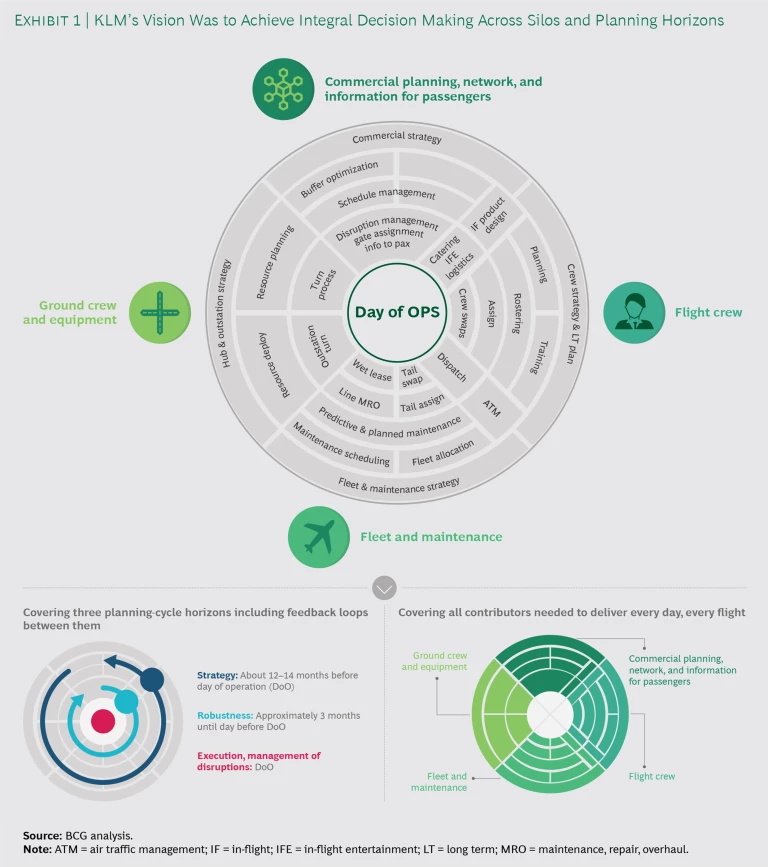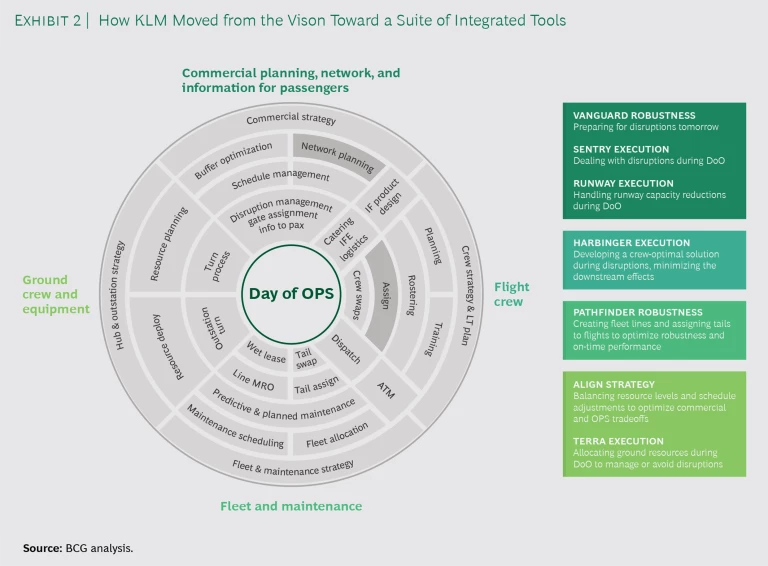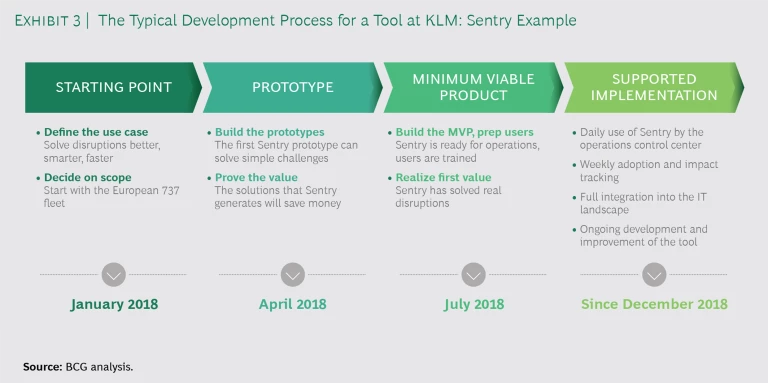KLM Royal Dutch Airlines turns 100 this year, and the airline is still leading the industry. Its mission includes becoming Europe’s most innovative (as well as customer-centric and efficient) network carrier. In 2017, KLM mounted a major effort to become the front-runner in digital operations—using data and advanced analytics to coordinate decision making involving fleet and ground operations, maintenance, crew, and passenger needs, for every flight every day. The biggest initial challenge was getting control of the siloed data, decisions, and planning horizons that often cause management to make operational tradeoffs more on the basis of gut feeling than a full analytical assessment of the options available and their ramifications.
By June 2018, the digital operations initiative was showing substantial success. For example, the airline was operating 8% more flights while improving on-time performance by 5 percentage points. KLM decided to offer a joint consulting service with its partners (BCG and BCG Gamma) to other airlines, a novel concept for the highly competitive industry. Several leading carriers have already signed on to the new service. (See “Improving the Industry’s Operating Performance.”)
IMPROVING THE INDUSTRY’S OPERATING PERFORMANCE
IMPROVING THE INDUSTRY’S OPERATING PERFORMANCE
The airline industry is known for intense competition in all aspects of the business, from the price of a ticket to service on the ground and in the air. Why, then, would one airline seek to share the success of its proprietary operations solutions with others in the industry? The answer can be found partly in the fact that the industry is also a vast ecosystem, in which the actions of one player can be felt in short order by another halfway around the world, and partly in the primacy of data for digital solutions.
As KLM saw the positive impact of its new tools on its operations, it decided to offer the solutions (in partnership with BCG and BCG Gamma) to others in the industry, with the suite fully tailored to each airline’s strategy and business objectives. Establishing a new revenue stream was one objective but another was delivering on its mission to be Europe’s most innovative network carrier: making its experience available to the broader market would force KLM to work even harder to retain its front-runner position. Moreover, as it worked with client airlines to build their capabilities, it would gain access (working within the constraints of competition laws and regulations) to new sources of operating data and the ability to exchange best practices with other teams and carriers, often involving much larger systems and networks.
A big part of the attraction for other airlines is the technology. It leverages the latest and most advanced AI techniques, integrating predictive analytics (including various kinds of machine learning that can predict delays and their ramifications) with the most advanced optimization techniques from operations research (such as mixed-integer programming, column generation, and various metaheuristics).
And it’s all optimized for parallel processing and deployed on the most powerful distributed infrastructures. These stochastic optimization models can recommend decisions in uncertain environments that are geared for overall value. Despite the inevitable complexity, the models can provide these solutions in a matter of seconds or minutes (as opposed to overnight)—a new paradigm for the integration of technology into day-to-day operational processes.
So far, others in the industry have been eager to replicate KLM’s digital success. KLM and BCG are already working with four major carriers around the world, including Delta in the US and GOL in Brazil, and expect others to join soon.
Here’s the story of how the world’s oldest airline uses the most advanced technology available to solve one of the industry’s thorniest dilemmas: dealing with operational tradeoffs. But it’s not just a tech tale—it’s as much about changing how management makes decisions in complex circumstances as about how it applies technology.
The Trouble with Tradeoffs
In 2017, BCG wrote about the tradeoffs that every airline needs to make in its daily operations to balance performance and profitability. Many airlines have difficulty simultaneously bridging organizational silos, managing the uncertainties of a business that is subject to multiple external influences, and planning for—and adjusting during—inevitable disruptions. Worse, managers often have a tough time knowing in advance whether they are making a good choice and frequently don’t have an effective way to find out. KLM and BCG have developed a better way, by taking an integrated and analytical perspective that examines all planning horizons (both long- and short-term as well as day of execution) and all processes (such as network scheduling, commercial planning, customer experience delivery, crew planning, and maintenance) and the tradeoffs among them. (See Exhibit 1.)
BCG has learned from working with airlines around the world that striking the right balance across the various factors affecting operational performance can help improve profitability, regardless of network strategy, region, or price point. But, as is often the case when solving complex business problems, no silver bullet applies to all carriers. For example, each airline needs to incorporate its strategy for customer service, its positioning in the market, and its investment appetite, so rigid off-the-shelf solutions won’t work. At the same time, few airlines are equipped to tackle this level of change on their own. Most do not have all the requisite technical skills in-house, and the organizational change involved is a major undertaking for any company.
Other factors come into play as well. A big one is that optimizing operational performance can never be fully automated. Although companies need the right systems in place, even a theoretical best-in-class carrier—armed with state-of-the-art processes, data, and technology—requires employees to apply good judgment and make smart decisions. (Among other things, passengers and front-line crew members need to know that they are not being routed entirely by an unseen artificial intelligence [AI] algorithm and that a human is still involved in determining which flights are delayed when disruptions occur.) While it’s important to prioritize and monitor critical flights and have playbooks ready to deploy, it’s even more crucial to clearly define decision rights and responsibilities and have the correct set of functions involved in the real-time decision making.
Five Guiding Principles
KLM has a history of entrepreneurship and embracing digital technologies in its commercial activities—it was the first major airline to use Facebook and Twitter as customer service tools, for example—and was intrigued by our approach. The carrier recognized the size and importance of the opportunity as well as the lack of available solutions. It also saw its own need to break down strong organizational silos and increase transparency, including in the operations control center (OCC) where, as with many airlines, controllers had their own ways of working and management had limited visibility on the value created by OCC decisions. KLM knew well that a culture of risk aversion, while critical for safety and reliability, made it difficult to test and experiment, especially on the legacy systems that control many essential functions.
KLM knew that a culture of risk aversion, while critical for safety and reliability, made it difficult to test and experiment.
To our general approach, KLM added five guiding principles specific to its own circumstances and needs:
- The ultimate business objective is to achieve integrated decision making throughout operations planning, control, and execution with a single source of truth—one comprehensive, reliable, and readily accessible source of data—spanning all key suppliers and planning horizons.
- For all decisions and processes, the company would strive to optimize tradeoffs and find win-wins among operational performance, customer satisfaction, efficiency, and employee engagement.
- Achieving the vision of optimized operations requires building critical new capabilities, and KLM would fully control and maintain these in-house. The airline would make or develop (as opposed to buy, source, or share) the required resources in order to keep decisions, competencies, and data under full company command.
- Think big, start small: the need to build credibility and fund the journey requires showing quick results to encourage adoption by front-line staff; the need for speed and the incorporation of user experience and feedback points to the importance of working according to an agile methodology.
- While the final result of this initiative will be an integrated suite of decision support tools using real-time data and sophisticated algorithms, most of the value and impact will come from the business transformation and the changes in ways of working that these tools will enable.
Practical Plans
Formulating the design principles was just a first step. The real challenge was translating them into concrete actions, deliverables, and practical ways of working. (See Exhibit 2.) A few key success factors got the ball rolling.
Full Senior-Management Support. The initiative had the backing of company leaders. This is important for any new corporate undertaking, of course. But in a large airline, where a misstep can disrupt hundreds of flights and thousands of passengers, the support of senior management, up to and including the COO, is essential if all participants are to accept and share responsibility for outcomes (and celebrate successes when things go well). Working in agile teams on a multifaceted, complex problem also requires a willingness to experiment, learn, and move on, which is a significant cultural shift for many companies, one that necessitates leadership from senior management.
Few Business Use Cases. KLM was able to translate the broad business vision of improved operational performance into a limited number of business use cases that involved substantial value and complexity. One was managing disruptions in operations control on the day of a significant disrupting event, such as bad weather. Another was planning for adjustments that improved robustness in the two weeks preceding the day of disruption. A third use case was managing resources in advance to meet commercial network objectives.
In selecting the use cases to pursue, KLM kept it simple. The company didn’t spend millions of euros preparing a master plan. Instead, senior managers built modest, agile, interdisciplinary teams to run a small number of initial projects and just got started. Little victories, with their attendant minor failures, served to clarify the kinds of organizational and process changes needed, allowing the organization to eventually move toward a more complex end vision in manageable steps. Small pilot projects catalyzed and calibrated such changes far more efficiently than the alternative of long-term, resource-intensive initiatives that hold out the promise of some distant, game-changing transformation.
Decision Support Tools. KLM focused on developing tools to provide decision support, including predictions and optimizations so that users can turn insights into action, rather than dashboards, data lakes, or historical analyses. For example, one tool provides the latest arrival time predictions, along with crew and passenger connection risk assessments and cost implications. It helps managers make informed decisions on which aircraft turnarounds to accelerate and which to deprioritize (including the impact on ground staff), decisions that most airlines make blindly today. Another tool provides all the relevant information during a disruption, when the OCC has minutes to combine data on available aircraft, passenger journeys, the schedule (including real-time updates related to incoming delays), available gates, and ground staff and maintenance. The tool can propose alternative ways to adjust the schedule with the lowest number of disrupted passengers.
A Decision Support Team. KLM understood that tools help but also recognized that humans need to use them effectively. Cross-functional cooperation is essential. The company created a “one operation decision support team” with line responsibility covering all operations. The team combines staff from front-line functions and departments as well as employees with new skills hired from outside. These team members include data scientists, data engineers, software engineers, and system architects. The group has line responsibility for both building and maintaining the new tools, and this instills a sense of ownership. The team’s vice president is a member of the operations management team and, like his or her colleagues, is accountable for the impact and results.
Building Momentum
KLM shifted gears as it started to develop and implement its first solutions for the use cases. (See Exhibit 3 for one example.)
Maintaining momentum and building credibility were critical. The airline put together solutions in short cycles of 6 to 12 weeks each. To keep demonstrating progress, it broke problems down into smaller component parts and later scaled up the solutions as needed. For example, instead of tackling maintenance scheduling for the entire fleet at once, KLM started with the aircraft that had the most potential for optimization (B737s), on the belief that a solution for that segment could be scaled up to the full fleet soon afterward. In addition, the agile approach of working in short (2-week) cycles enabled development teams to encourage user adoption by addressing feedback immediately. This helped the organization gain confidence in the project and made everyone feel part of the process.
Until companies develop a management model that is equal to the challenges of the social, economic, and business changes taking place today, the organizational changes that they are trying to implement won’t be successful. Developing such a managerial model Bringing Managers Back to Work. Put simply, they need to stop thinking of themselves as the master designers of hardwired organizational structures, processes, rules, and procedures. Instead, managers need to become the everyday orchestrators of a flexible and dynamic behavioral system, one that avoids traps, unleashes employees’ autonomy and initiative, and puts them in the service of more effective cooperation to achieve the organization’s goals.
To this end, KLM set up systematic action-focused evaluations of the adoption and impact of each solution in every department. For each tool, the development team meets weekly with the full team to review impact and adoption, and a summarized evaluation is provided to the COO and any direct reports. Assessments focus on the impact that users have achieved by adopting the new tools. Because the process crosses teams and silos, managers must become sufficiently familiar with workflow details that they can support the teams in making the right tradeoffs. End users and managers together lead the business transformation toward more-streamlined processes enabled by technology (for example, decreasing the number of handovers and meetings and replacing assumptions with actual information).
KLM involved front-line staff (and their managers) in building the solutions expressly so that employees would use the new tools and get excited about the latest resources under development. It located development teams in the OCC, side by side with the controllers, where they could work together to deal with real-life disruptions and identify opportunities to improve the tools in such areas as user interface and features. Development teams were also on site at key moments, such as the Sunday morning changeover to summer (daylight saving) time and a new schedule.
The company also made sure to share its successes with the staff. Whenever it reached a new milestone, such as another tool going live or a significant solution being implemented, it celebrated the milestone with everyone involved. While the KLM culture was already very much focused on improvements, top management believed it was important to recognize visibly how much the organization was achieving and what the teams were working so hard to accomplish.
Over a period of about two years, KLM developed best-in-class, ground-breaking algorithms to help its staff tackle the biggest operational tradeoffs and problems. But the real reason it succeeded, where others have not, was a willingness to tackle the management and operations challenges as well as the tech development. As the COO of another large airline put it after assessing the KLM solution in detail, “We have talked about this for years, but you just rolled up your sleeves and did it.”
The real reason KLM succeeded, where others have not, was a willingness to tackle the management and operations challenges as well as the tech development.
Achieving Operational Transformation
The impact of KLM’s solutions has been significant for customers, front-line staff, and the bottom line. For example, on a recent day, 3 aircraft from a fleet of 51 could not be used—for three different reasons—and the airline was looking at flight cancellations and delays disrupting several thousand passengers; the new solution took only a few minutes to propose 42 aircraft swaps and a combination of short and long delays that avoided cancellations and fashioned a new, feasible schedule. Thanks to the cross-functional operations team, these changes were validated and implemented within a minute, and the OCC reduced the number of delayed passengers by almost 40%.
Every day, the new suite of solutions allocates individual aircraft to the European schedule. By simultaneously optimizing maintenance, passenger connections, and on-time performance, including real-time delay predictions for crews and their connections, the OCC can reduce the number of delay minutes by at least 20%.
Now that the tools have been in use for several months, management can see the changes taking place in how people do their jobs. Front-line staff members are embracing these tools more and more as part of their normal way of working and are actively contributing to new releases and features. Transparency and mutual understanding among departments have started to increase. For example, when the operations controller one day made 38 aircraft swaps, causing the catering logistics team to ask if this was necessary, a quick explanation of the value at stake was sufficient for everyone to understand the situation and move forward with implementation.
Teams now also propose their own changes to processes and decision making. The daily aircraft allocation described above is now done late the night before by operations control instead of the maintenance department so that it takes into account all key functions, as well as the latest weather, booking, and maintenance data.
The nature of the OCC job is changing from urgent problem solving (executing changes within the silos) to analytical assessment (weighing the impact of different scenarios across the team). For example, the new “Runway” tool proposes the optimal schedule with the lowest overall disruption across network, commercial, crew, maintenance, and ground staff, and the controllers of the different departments jointly validate the proposed solution. The performance management of operations control has become fact-based, and the key objective is to review the impact of decisions after they’re made and assess how further improvements can lead to additional benefits.
Because the tools handle a big part of the initial problem solving, operators can focus more on strategic decision making.
The biggest benefits to KLM, though, are in the business transformation the new tools have enabled. Because the tools handle a big part of the initial problem solving, operators can focus more on strategic decision making (for example, deciding whether to implement the solution now or see how things unfold) and analyzing performance during disruptions and then contributing to the next release of the tool.
And, with the tradeoffs among the various impacts of disruption (such as passenger dissatisfaction, crew reserve usage, hotel costs, and voucher expenses) quantified at the individual flight level, operators can now make much more informed and action-oriented decisions. No longer do they need to discuss the cost of a flight delay if the plane waits for a passenger or crew member; the tools not only tell them what the cost is, they also compare that with the cost for the other flights (as well as crews and passengers) that will be affected. Or, when a storm disrupts operations, the OCC can assess—with the facts in hand—whether it made the right decisions and what it should do differently next time, including changing the settings and objectives of the tools.
The tools involve everyone in the decision making. With the front line chipping in ideas for additional initiatives, opportunities, and features, setting priorities is more important than ever. Following the agile methodology, KLM now holds quarterly “program increment planning events,” in-person sessions in which the operations decision support team, together with business managers, makes the tradeoff decisions on where to invest their collective efforts according to the expected overall impact and required effort.
Using the weekly impact and adoption reports, they can now achieve a new level of accountability for results by adding aggregated views to the performance management cycle at the department level. In time, as the systems gain experience and knowledge, the nature of front-line controllers’ responsibilities will change toward even more analytical (as opposed to executional or problem-solving) tasks, requiring the retraining and repurposing of employees.
Airlines are data-intensive businesses. Combined with today’s advanced analytics, AI, and machine-learning expertise, the data that airlines generate can be used to solve the most complex operational problems. But technology is only one part of the answer. KLM’s most important insight was to marry advanced technology with structural management changes and new ways of working in order to fully enable new capabilities across its operations.
As it enters its second century, KLM is the industry’s clear leader in digital operations. And, unlike most companies in most industries, KLM is sufficiently comfortable in its position to be willing to offer its expertise to others.









